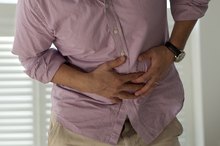What does fact checked mean?
At Healthfully, we strive to deliver objective content that is accurate and up-to-date. Our team periodically reviews articles in order to ensure content quality. The sources cited below consist of evidence from peer-reviewed journals, prominent medical organizations, academic associations, and government data.
- National Center for Biotechnology Information: Exercise-Induced Nausea is Exaggerated by Eating
- National Center for Biotechnology Information: Exercise-Induced Nausea is Exaggerated by Eating
- MayoClinic.com: Abdominal Pain
- MayoClinic.com: Inguinal Hernia
The information contained on this site is for informational purposes only, and should not be used as a substitute for the advice of a professional health care provider. Please check with the appropriate physician regarding health questions and concerns. Although we strive to deliver accurate and up-to-date information, no guarantee to that effect is made.
Normally, a stomachache isn’t a cause for alarm. Even during exercise, it’s likely a result of food or your level of physical exertion. Your timing of meals, the amount of food you eat and the intensity of your exercise can all lead to stomach discomfort for some people. But sharp or severe pain during lifting weights could be an indication of something more serious.
If you are experiencing serious medical symptoms, seek emergency treatment immediately.
Diet
Certain dietary habits can sometimes lead to stomachaches while lifting weights. A study conducted by the Department of Human Nutrition at the Research Center of Health, Physical Fitness and Sports in Japan showed that exercise can lead to what’s known as exercise-induced nausea 1. Eating too little or too close to a workout session had the greatest impact on the occurrence of nausea, so the amount of food you’re eating as well as when you’re eating it could be contributing to your discomfort. A small snack at least 60 minutes prior to your workout may be the answer.
- Certain dietary habits can sometimes lead to stomachaches while lifting weights.
- A small snack at least 60 minutes prior to your workout may be the answer.
Intensity
Abdomen Inflamed Because of Physical Exercise
Learn More
The intensity of your workout can be playing a role in your stomach discomfort. The Department of Human Nutrition study demonstrated that high-intensity exercise is more likely to lead to exercise-induced nausea during a workout than low-intensity. Easing up on the intensity during a lifting session could help alleviate or prevent a stomachache.
- The intensity of your workout can be playing a role in your stomach discomfort.
- The Department of Human Nutrition study demonstrated that high-intensity exercise is more likely to lead to exercise-induced nausea during a workout than low-intensity.
Strain
The stomachache you’re feeling can also be an indication of a muscle strain. Lifting weights can cause your abdominal muscle to stretch beyond their normal capacity. Even when you’re not working the core of your body, you’re likely engaging your abs to lift the weight. Especially when the weight is heavy, the force created during the movement can stretch or even tear am abdominal muscle. This pain can be similar to a stomachache. Giving your workout a rest should help heal the strain. As soon as you can move your torso without experiencing pain, it’s probably safe to return to your regular activities.
- The stomachache you’re feeling can also be an indication of a muscle strain.
- As soon as you can move your torso without experiencing pain, it’s probably safe to return to your regular activities.
Hernia
Weightlifting & Abdominal Pain
Learn More
If your stomach discomfort emanates within your lower abdominal region, it could be an indication of a hernia. A hernia occurs when part of your intestines protrudes out of a tear along your lower abdominal wall. Heavy lifting can cause this. Smaller hernias may not need treatment, but often requires surgery. Talk to your doctor about the problem.
- If your stomach discomfort emanates within your lower abdominal region, it could be an indication of a hernia.
Related Articles
References
Writer Bio
Based in Minneapolis, Minn., Dana Severson has been writing marketing materials for small-to-mid-sized businesses since 2005. Prior to this, Severson worked as a manager of business development for a marketing company, developing targeted marketing campaigns for Big G, Betty Crocker and Pillsbury, among others.









